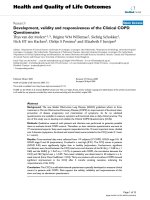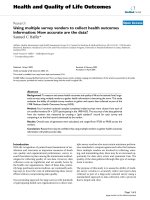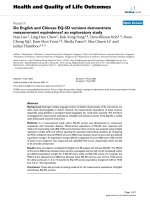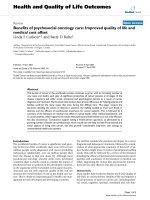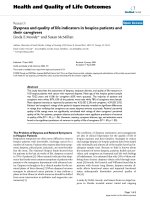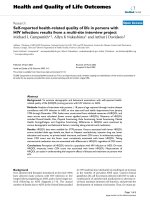Health and Quality of Life Outcomes BioMed Central Review Open Access The impact of urinary ppt
Bạn đang xem bản rút gọn của tài liệu. Xem và tải ngay bản đầy đủ của tài liệu tại đây (202.16 KB, 3 trang )
BioMed Central
Page 1 of 3
(page number not for citation purposes)
Health and Quality of Life Outcomes
Open Access
Review
The impact of urinary incontinence on self-efficacy and quality of life
Barbara Ann Shelton Broome*
Address: University of South Alabama College of Nursing, Mobile, AL, USA 36688-0002
Email: Barbara Ann Shelton Broome* -
* Corresponding author
Abstract
Urinary incontinence impacts 15 to 35% of the adult ambulatory population. Men after the removal
of the prostate for cancer can experience incontinence for several weeks to years after the surgery.
Women experience incontinence related to many factors including childbirth, menopause and
surgery. It is important that incontinence be treated since it impacts not only the physiological, but
also the psychological realms of a person's life. Depression and decreed quality of life have been
found to co-occur in the person struggling with incontinence.
Interventions include pharmacological, surgical as well as behavioral interventions. Effective
treatment of incontinence should include the use of clinical guidelines and research to promote
treatment efficacy.
Urinary Incontinence
Urinary incontinence (UI) impacts an estimated 15 to
35% of the adult ambulatory population 60 and older
that live in the community with prevalence rates for
women being twice that of men [1,2]. There is a variance
in epidemiological data regarding urinary incontinence
(UI) prevalence rates because of inconsistent definitions
of incontinence, differences in questionnaires, settings,
and methodology, as well as the reliability of self-report
data [3–7,2]. Also contributing to the variance in reported
prevalence may that many sufferers fail to report the
occurrence of UI to their health care provider because of
the belief that incontinence is a normal phenomena asso-
ciated with aging or that UI is untreatable. There is also the
stigma associated with not being able to control the basic
functions of elimination.
Implications
Involuntary loss of urine has multiple implications for the
sufferer [6,8]. Incontinence also has been noted to be a
major barrier to social interests, entertainment, or physi-
cal recreation [9–11].
Depression
Depression and anxiety have been suggested to co-occur
in incontinent persons [1,12,9,13,14]. Several researchers
have found a link between incontinence and depression
[15–17]. It is unclear if the incontinence causes depres-
sion or if depression causes incontinence. However, it is
clear that a relationship exists. Bandura (1977a) proposed
that depression will occur when either self-efficacy or out-
come expectancy is low. There is thought to be a reciprocal
relationship among self-efficacy, performance, and one's
emotional state [18–20]. Depression is described as "an
alteration in mood ranging from a mild sadness to over-
whelming despair. It is characterized by feelings of sad-
ness, emptiness, dissatisfaction, lowered self-esteem,
inactivity, and self-depreciation" [21].
Depression may be created by personal perception of cog-
nition, negative events, and physiological states. Depres-
Published: 22 August 2003
Health and Quality of Life Outcomes 2003, 1:35
Received: 03 July 2003
Accepted: 22 August 2003
This article is available from: />© 2003 Broome; licensee BioMed Central Ltd. This is an Open Access article: verbatim copying and redistribution of this article are permitted in all media
for any purpose, provided this notice is preserved along with the article's original URL.
Health and Quality of Life Outcomes 2003, 1 />Page 2 of 3
(page number not for citation purposes)
sion occurs when one feels a perceived inefficacy in
controlling valued outcomes [22]. This perception
impacts the choice of activities one chooses to engage in
and the effort and persistence one is willing to invest in
the activity [22,23]. Self-evaluation of accomplishments
are often devalued by those with low self-efficacy because
success is based on high performance standards [22].
When outcomes are highly valued, depression is likely
when outcome expectancy is high and performance expec-
tation is low [22,23].
Self-efficacy and Quality of Life
Women with UI are also more likely to report a poorer
quality of life [10,24]. The effect of self-efficacy on quality
of life has been investigated in several studies of health
related behaviors. Self-efficacy and quality of life are pos-
itively related while depression and self-efficacy are nega-
tively related. The choices, goals, effort, and persistence of
an individual can be impacted by individual self-efficacy
[18,22]. Interventions that are tailored to increase self-
efficacy may improve depression and quality of life.
Financial Impact
The total cost of UI in 1995 was reported to be more than
16.4 billion dollars annually Hu, 1990). Of this total 11.2
billion dollars is spent for community dwelling individu-
als and an additional 5.2 billion dollars is spent on conti-
nence care in the institutional setting [1,25]. Findings of a
study by Baker and Bice (1995) indicated that individuals
with UI: 1) suffered more disability; 2) are more likely to
use more expensive paraprofessional service and purchase
medical equipment; and 3) cost an estimated 25% more
to the public in home care costs.
Treatment
Controlling incontinence may be pharmacological, surgi-
cal or behavioral in nature. The first line of intervention is
recommended to be the least invasive in nature, such as
the case in pelvic muscle exercises [1]. Pharmacological
agents may also be used in conjunction with pelvic muscle
exercises to promote the return to continence. There is a
reported 61% increase in continence in women using pel-
vic exercises as an intervention for incontinence and
reported improvements in quality of life.
Treatment of UI is based on a thorough assessment to
confirm the presence of UI, the type of UI, identification
of contributing factors, and the determination of patients
that may require further evaluation prior to any therapeu-
tic interventions.[1]. The information obtained during
assessment is also vital in implementing the appropriate
treatment for UI. Treatment and interventions for UI are
medications, mechanical devices, surgery, and behavioral
modification. Several medications have proved beneficial
for UI; however the risk to benefit ratio is not clear.[1].
Estrogen replacement therapy may also be useful for UI
and has been used in women that have estrogen deficien-
cies to reduce urgency and frequency of urge UI and in
combination with adrenergic agonists to treat stress UI
[26,6]. The side effects of the pharmacological agent used,
the characteristics of the UI, and patient and physician
preference must all be weighed in the decision to use med-
ications as an intervention [26].
Surgery has also proved to be effective when other inter-
ventions for pelvic prolapse, bladder neck, or urethral
obstruction fail [26,27]. Surgery may also be indicated in
certain cases of stress UI that are not responsive to phar-
macological and behavioral interventions [26]. However,
the long-term results of surgery for UI remain under inves-
tigation. Mechanical devices such as urethral plugs,
weighted vaginal cones, and pessarys have been shown to
be effective in selected situations.[1]. Behavioral interven-
tions have also been shown to be successful as a treatment
for stress and urge UI [28,29], although the long-term
effects of these therapies also need further study.[1].
Theoretical Models
There are few theoretical models that have been devel-
oped to organize data and research results related to
incontinence research. Because UI impacts the social,
physiological and psychological domains, the models
used must be holistic in nature. One model that has been
described is self-efficacy. Self-efficacy is described as the
personal judgments one makes about ability to execute
courses of action in a particular set of situations [18,23].
Social Cognitive Theory was the foundation from which
self-efficacy theory was derived. Self-efficacy theory pro-
poses that outcomes are determined by one's actions.
One's perception of capabilities will impact how one
behaves, the level of motivation, thought patterns, and
emotional reactions in taxing situations [18,19]. The
measurement of self-efficacy for the performance of pelvic
muscle exercises as a behavioral intervention for UI can
provide important information regarding one's motiva-
tion and belief about the efficacy of the prescribed inter-
vention. The measurement of self-efficacy may also
provide a foundation for better understanding the rela-
tionship between self-efficacy and successful outcomes
[30,31].
The Broome Pelvic Muscle Self-efficacy Scale was devel-
oped using Bandura's self-efficacy theory and has demon-
strated utility in predicting success in behavioral
interventions for incontinence in women [32,33]. Testing
of the scale in men with post-prostatectomy incontinence
is ongoing. To date there no preliminary data describing
the relationship between self-efficacy and the success of
remediation for post prostatectomy incontinence.
Health and Quality of Life Outcomes 2003, 1 />Page 3 of 3
(page number not for citation purposes)
Clinical Care Guidelines
There should be a routine assessment for incontinence in
all health care settings.
Practice guidelines should be developed for clinician use.
Emphasize preventative and restorative care.
Develop a multidisciplinary and holistic approach to con-
tinence care.
Necessary Research
Conduct research on comparing intervention effective-
ness.
Continue research on the impact of self-efficacy on out-
comes.
Conduct longitudinal studies to evaluate interventions.
Evaluate continence outcomes on self-efficacy, depression
and quality of life.
Conduct studies on interventions for men with inconti-
nence.
Conduct research in minority populations.
References
1. Research Agency for Health Care Policy and: Clinical practice
guideline: Urinary incontinence in adults: Acute and chronic
management. Rockville,MD, U.S. Government Printing Office; 1996.
2. Thom DH: Overactive bladder: Epidemiology and impact on
quality of life. 2000 [ />8_45/65195580/p1/article.jhtml].
3. Abrams P: Incontinence: Proceeding from the second interna-
tional consultation on incontinence. Plymouth, UK, Health Publica-
tions; 2001.
4. Diokno C, Brock BM, Brown MB and Herzog AR: Prevalence of
urinary incontinence and other urological symptoms in the
noninstutionalized elderly. The Journal of Urology 1986,
136:1022-1025.
5. Mohide EA: The prevalence and scope of urinary inconti-
nence. Clinics in Geriatric Medicine 1986, 2:639-655.
6. Conference National Institutes of Health Urinary Incontinence Con-
sensus: Urinary incontinence in adults. Journal of the American
Medical Association 1989, 261:2685-2690.
7. Resnick N, Beckett L, Branch L, Scherr P and Wetle T: Short-term
variability of self-report incontinence in older persons. Journal
of the American Geriatrics Society 1994, 42:202-207.
8. Ouslander J and Schnelle J: Incontinence in the nursing home.
American College of Physicians 1995, 122:438-449.
9. Grimby A, Milson I, Molander U, Wiklund I and Ekelund P: The influ-
ence of urinary incontinence on the quality of life of elderly
women. Age and Aging 1993, 22:82-89.
10. Hunskaar S, and Vinsnes A: The quality of life in women with uri-
nary incontinence as measured by the sickness impact pro-
file. The American Geriatrics Society 1991, 39:378-382.
11. Wetle T, Scherr P, Branch LG, Resnick NM, Harris T, Evans D and
Taylor JO: Difficulty with holding urine among older persons
in a geographically defined community: Prevalence and cor-
relates. Journal of the American Geriatrics Society 1995, 43:349-355.
12. Burgio KL, Whitehead WE and Engel BT: Urinary incontinence in
the elderly: Bladder-sphincter biofeedback and toilet train-
ing skills. Annals of Internal Medicine 1985, 104:507-515.
13. MacCauley AJ, Stern RS, Holmes DM and Stanton SL: Micturition
and the mind: Psychological factors in the aetiology and
treatment of urinary symptoms in women. British Medical Jour-
nal 1984, 294:540-543.
14. Rosenzweig BA, Hischke D, Thomas S, Nelson AL and Bhatia NN:
Stress incontinence in women: Psychological status before
and after treatment. The Journal of Reproductive Medicine 1991,
36:835-838.
15. Meade-D'Alisera P, Merriweather T, Wentland M, Fantl M and Ghafar
M: Depressive symptoms in women with urinary inconti-
nence: A prospective study. Urologic Nursing 2001, 21:397-400.
16. Watson AJ, Currie L, Curran S and Jarvis GJ: A perspective study
examining the association between the symptoms of anxiety
and depression and severity of urinary incontinence. European
Journal of Obstetrics & Gynecology & Reproductive Biology 2000, 88:7-9.
17. Zorn BH, Montgomery H, Poeper K, Gray M and Steers WD: Uri-
nary incontinence and depression. Journal of Urology 1999,
162:82-84.
18. Bandura A: Self-efficacy: Toward a unifying theory of behavio-
ral change. Psychological Review 1977, 84:194-215.
19. Bandura A: Social learning theory. Englewood Cliffs, NJ, Prentice-
Hall; 1977.
20. Yusaf SO, and Kavanagh DJ: Mechanisms of improvement in
treatment for depression: Test of a self-efficacy and per-
formance model. Journal of Cognitive Psychotherapy: An International
Quarterly 1990, 4:51-70.
21. Lewis S and Grainger RD: Manual of psychosocial nursing inter-
ventions: Promoting mental health in medical-surgical set-
tings. The patient with depression Philadelphia, W.B. Saunders Co.; 1989.
22. Bandura A: Self-efficacy mechanisms in human agency. Ameri-
can Psychologist 1982, 37:122-147.
23. Bandura A: Social foundations of theory and action: A social
cognitive theory. Englewood Cliffs, NJ, Prentice-Hall; 1986.
24. Wyman JF, Harkins S, Choi S, Taylor JR and Fantl A: Psychosocial
impact of urinary incontinence in women. Obstetrics and Gyne-
cology 1987, 70:378-381.
25. Wagner TH and Hu TW: Economic costs of urinary inconti-
nence in 1995. Urology 1998, 51:355-361.
26. Kane RL, Ouslander JG and Abrass: Incontinence. Essentials of clini-
cal geriatrics 3rd edition. New York, McGraw-Hill, Inc; 1994.
27. McCormick KA, Newman DK, Colling J and Pearson BD: Urinary
incontinence in adults. American Journal of Nursing 1992, 92:75-88.
28. Burgio K, Courtland-Robinson J and Engel B: The role of biofeed-
back in Kegel exercises training for stress urinary inconti-
nence. American Journal of Obstetrics and Gynecology 1986, 154:58-64.
29. McDowell BJ, Burgio K, Dombrowski M, Locher J and Rodriguez E:
An interdisciplinary approach to the assessment and behav-
ioral treatment of urinary incontinence in geriatric outpa-
tients. Journal of the American Geriatrics Society 1992, 40:370-374.
30. Grembowski D, Patrick D, Diehr P, Durham M, Beresford S, Kay E
and Hecht J: Self-efficacy and health behavior among older
adults. Journal of Health and Social Behavior 1993, 34:89-103.
31. Hofstetter CR, Sallis JF, Hovell MF, Bryon M, Jones S, Rummanni S,
Scott K, Wagers and Weiss D: Some health dimensions of self-
efficacy: Analysis of theoretical specificity. Social Science and
Medicine 1990, 31:1051-1056.
32. Broome B: Psychometric analysis of the Broome Pelvic Mus-
cle Self-efficacy Scale in African-American women with
incontinence. Urologic Nursing 2001, 21:289-297.
33. Broome B: Development and testing of a scale to measure
self-efficacy for pelvic muscle exercises in women with uri-
nary incontinence 19(4), 258-268. Urologic Nursing 1999,
19:258-268.


